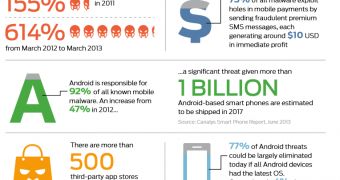Juniper Networks has released its annual Mobile Threats Report, a study based on information collected from March 2012 to March 2013 by the company’s Mobile Threat Center.
According to the study, the number of mobile malware threats has increased by 614% over the one year period monitored by the company. More precisely, a total of 276,259 malicious apps have been identified.
As expected, cybercriminals continue to focus on the Android platform, 92% of the pieces of malware identified by Juniper’s Mobile Threat Center being aimed at Google’s operating system. It’s interesting to note that, in 2010, only 24% of mobile malware targeted Android.
When it comes to the distribution of mobile malware, cybercriminals usually rely on third-party application stores.
Experts have identified over 500 Android app stores worldwide, many of them being abused to distribute malware because they have low levels of oversight and accountability. Around 60% of these third party app stores are hosted in Russia or China.
Fake Installers or SMS Trojans continue to be the most popular among cybercriminals because they can bring quick profit.
The fragmentation of the Android ecosystem is fully exploited by cybercriminals. According to Google’s own figures, only 3% of Android users are running the latest version of the operating systems, which means that there are plenty of victims to choose from.
“With mobile malware on the rise and attackers becoming increasingly clever, we need better protection for mobile users and corporations,” said Michael Callahan, vice president of global product marketing for the Security Business at Juniper Networks.
“While on one hand the OEMs, carriers and software vendors must collaborate to develop platforms that mitigate large threats, enterprises and government organizations need to take a comprehensive look at protecting their data and networks by adopting a holistic approach to mobile security.”
An executive summary of the Juniper Networks report is available here. The complete study is available here (registration required).

 14 DAY TRIAL //
14 DAY TRIAL //